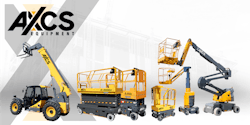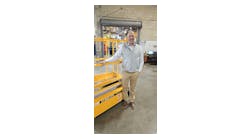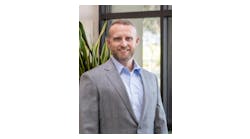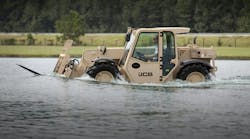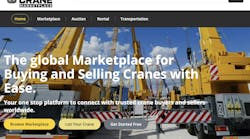Interviews with Aerial Manufacturers: Maximizing Utilization with Technology, Part 1
Participants:
Malcolm Early, vice president marketing, Skyjack
Joe Leinwol, chief sales officer, Magni America
Paul Jensen, product marketing manager, Haulotte
Jeffery Eckhardt, p.e., vice president engineering, Xtreme Manufacturing & Snorkel
Joey Liu, marketing specialist, Sinoboom North America
Rogerio dos Santos, vice president of strategy and product management, JLG Industries
Dickey Bennett, Director of Key Accounts Sales, LGMG
Mark Elton, Director of Research & Development, LGMG
Ben Bradshaw, executive vice president, North American sales, Genie
Scott Owyen, director of training, North America, Genie
What do you see as some of the new trends in mobile elevating work platforms and telehandlers (not just with your company’s products). What are customers particularly looking for?
Early: I think if we look at fundamentals the rental industry is looking to OEMs for continued and improved return on investment. It is important to remember this as we talk of other trends, whether that be in terms of technology or sustainability, they do not come at any cost, and if they do come at a cost that cost needs to be recoverable in terms of rental rates or productivity. Both in aerials and telehandlers there is much discussion on electrification and its role in a more sustainable product offering and a more sustainable rental industry. Today, that trend has its origins in government policy and initiatives that can be leveraged through spending, a large part of which is on infrastructure and construction.
In this way contractors have sustainability objectives to meet and if rental companies are to be successful, they too need to look at the sustainability agenda when dealing with contractors. From a Skyjack perspective, we have always focused on the rental industry and through that focus we understand that technology used to deliver some of sustainability objectives needs to be up to the job and not just cool for cool’s sake. In that way, when we introduced E-drive to our DC scissor range, we ensured that the technology was well proven and that the technology itself did not increase product cost and was able to deliver lower life-time costs for the rental industry.
Leinwol: The construction industry is undergoing a transformative phase, driven by the need for more efficient, safer, and technologically advanced equipment. As job sites become increasingly complex, the demand for versatile, high-performing machines like mobile elevating work platforms (MEWPs) and telehandlers is at an all-time high. These trends are reshaping the landscape of construction equipment, and at Magni, we are not just keeping pace with these changes—we’re setting the standard.
The modern jobsite demands equipment that can adapt to a variety of tasks without sacrificing performance. This has led to an increased focus on the versatility and multifunctionality of telehandlers. Magni’s telescopic handlers are designed to be more than just lifting machines. With a wide range of attachments—from forks and winches to man baskets, hooks, jibs, winches, and more—our telehandlers can easily switch between tasks such as material handling, personnel lifting, and site cleanup. This adaptability not only maximizes the utilization of each machine but also reduces the need for multiple types of equipment on a job site, ultimately saving space and costs for rental companies and their customers.
Additionally, all of our attachments are equipped with RFID recognition, which automatically updates the load charts in real time. This provides operators with quick, accurate, and extremely safe operation—no paper charts are required.
Jensen: Our customers are looking for safe and reliable machines that have the lowest down times possible. Haulotte is supporting that need with a suite of digital products that are helping owners, operators, and technicians. The Haulotte Activ’Screen is leading the industry with diagnostic and configuration tools located right on the machine, no diagnostic tool required. Technicians are given plain text information about trouble codes as well as drawings locating the parts that are affected, and instructions on how to return the machine to service as quickly as possible.
Sherpal, Haulotte’s telematics solution, builds on the data presented on the Activ’Screen and transmits all the same machine status and diagnostics information to the cloud for easy access and analysis either on the MyHaulotte.com web platform or the customer’s own ERP. Fleet managers can quickly see the location and health of their connected machines, and plan for effective technician visits when needed. Haulotte digital tools keep operators informed about machine status, reduce downtime with onboard rapid diagnostic tools, and reduce TCO with effective fleet management and analysis tools.
Eckhardt: The newer MEWP industry trends include compact/mini lifts, high-capacity boom platforms and crawler/spider lifts. Compact/mini lifts are being utilized in confined spaces during and post construction, to limit the amount of damage that can be caused by larger lifts when navigating the project to complete tasks. The trend for these machines also includes electric drive/electric steer, lithium technology, and no fold down rails. The electric drive/electric steer conversion assists with limiting the need for hydraulic usage in drive and steer. Less hydraulic functions reduce the exposure to potential hydraulic leaks. Furthermore, the rapid maturation of Lithium-ion technology is benefiting the MEWP industry with longer run times and less battery maintenance, compared to lead-acid batteries.
High-capacity boom lift platforms are provided to accommodate people, tools, and materials to complete tasks safer, faster, and more efficiently. The higher capacity boom platforms allow operators to bring additional personnel, tools and/or materials while performing elevated tasks; ultimately reducing job times while mitigating job site accidents.
The crawler/spider lift space is increasing as demand rises. The rise of demand is due to project needs such as floor loads, confined entry/exit spaces and structure design complexity. More specifically, this increase in demand within the construction industry includes the need to accommodate for flat glass products. Rising developments in the commercial sector can benefit from the efficiency provided by these types of lifts and is anticipated to augment market growth in the coming years.
Liu: A significant trend in MEWPs is the shift towards electrification, driven by the global green movement and the need for sustainability. Countries like the U.S., Europe, Australia, and especially China are seeing a rise in electric and hybrid models, not only for aerial platforms but also for heavier equipment. While slab scissors have already achieved high levels of electrification (around 95 percent), other types of booms are steadily adopting electric power. This trend is expected to grow over the next five years, especially in North America.
Additionally, the use of artificial intelligence (AI) is becoming more prevalent, particularly in tasks that are repetitive or labor-intensive. AI enhances productivity, lowers labor costs, and increases safety. The rise of big data and IoT is transforming fleet management, enabling smarter and more efficient control of rental fleets through telematics and predictive maintenance. These combined trends reflect a broader push toward more efficient, environmentally conscious, and technologically advanced equipment in the MEWP industry.
Dos Santos: Although most of these are not new, trends in what customers are requesting in MEWPs include:
1. Higher capacities: Customers seek MEWPs that can lift heavier loads. This trend is driven by the need to increase productivity by moving more materials or supporting more workers on a single platform. Higher capacity MEWPs allow for fewer trips and more efficient use of time and resources on job sites.
2. Compact sizes: There's a growing demand for smaller, more maneuverable MEWPs operating in confined spaces. This is particularly important in urban construction, renovation projects and industrial settings where space is at a premium. Compact MEWPs offer greater accessibility and versatility in tight work areas.
3. Versatility: Multi-purpose MEWPs are becoming increasingly popular. Customers prefer machines that can perform various tasks, reducing the need for multiple (pieces of) specialized equipment. This versatility can lead to cost savings, improved efficiency, and simplified fleet management.
4. Environmentally friendly operation: With growing environmental concerns and stricter regulations, there's a shift towards MEWPs with low or zero emissions, reduced noise levels and minimal fluid leakage. These eco-friendly features allow operation in sensitive areas like hospitals, schools and indoor spaces, as well as in jurisdictions with strict environmental regulations.
5. Connectivity: MEWPs are increasingly being integrated into the broader construction ecosystem through IoT (Internet of Things) technologies. This connectivity enables real-time monitoring of machine performance, predictive maintenance, fleet management, and data-driven decision-making. It can also enhance safety by providing remote diagnostics and operation oversight.
6. Autonomous operation: There's growing interest in MEWPs with autonomous or semi-autonomous capabilities. These features can improve safety by reducing human error, address labor shortages by allowing one operator to manage multiple machines and increase efficiency by optimizing movement and positioning. Autonomous functions can range from simple self-leveling to complex navigation and task execution.
These trends collectively point towards a future of MEWPs that are more capable, efficient, safe and sustainable while also being better integrated into modern construction management practices.
Bennett, Elton: One significant trend in the MEWP industry is the growing popularity of larger booms, particularly those over 85 feet. Models in the 120 to 125-foot range, and even extremely tall booms exceeding 200 feet, are becoming more common as job sites demand machines that can handle greater heights.
In addition, the availability of more robust standard features has become a priority for both manufacturers and customers. At LGMG, we have made features such as cylinder bellows and boom wipers standard inclusions on all booms. These bellows help keep dirt and grime out of critical components, like cylinder rods, extending the life and reliability of the machines. Similarly, our upper control box covers are standard on all LGMG booms to prevent accidental activation of the controls and protect them from the elements, which enhances both safety and machine durability.
Leak containment systems are also becoming a standard feature across the industry, particularly on slab scissor lifts. These systems help manage hydraulic leaks, ensuring job sites remain clean and safe. While many manufacturers offer leak containment as an option, LGMG has made it a standard feature on our scissor lifts, ensuring customers are provided with a more environmentally responsible machine without the need to add additional options.
These trends demonstrate how manufacturers are focused on building more durable, safer, and environmentally friendly machines that cater to the evolving needs of customers while staying aligned with regulatory requirements.
Bradshaw: Taking the second part of the question first, customers are really looking for some of the same things that have always been important in our industry. They want equipment that is cost-effective to own and maintain, ready to rent when their customers need it, reliable and productive on the jobsite. That segues into trends, because right now, some of the biggest trends—or at least some of the hottest topics—relate to technology. As we’ve seen equipment owners exploring how technology can benefit their businesses, like they’ve done with telematics, which have become a larger focus over the last few years. We’re at the point where we’re getting a glimpse of some of the things that are coming. And the industry as a whole, I think, is looking at how it can help make MEWPs and telehandlers safer, more productive, and more cost-effective.
So, circling back to what our customers are looking for, I think one of the things rental equipment owners are looking for in a manufacturer is a partner who is thinking about where things are going, and how technology can be implemented in a thoughtful, purposeful, cost-effective way that helps them better serve their customer’s jobsite needs while also adding value for their business through things like reduced service and maintenance and fewer replaceable parts to purchase and stock.
What improvements are being made in the aerial industry in regard to safety, in your products and in the industry as a whole? Are there particular areas of safety you feel need to be addressed more, i.e., falls from height, electrocutions, entrapments, tools falling out of platforms, etc.?
Early: Of course, I would look for us to provide continuous improvement in this area so that accidents are minimized. These are products that you need training to operate safely, and we encourage any organization that promotes appropriate training.
Technology can also help here. Available on all Skyjack machines a QR code system, ELEVATE Live, allows operators to access information like emergency lowering procedures, pre-use inspection guides, familiarization materials, and a machine’s current state of health helping rental companies save money and reduce workloads.
When you talk about particular areas, one area comes to mind. We saw a tendency for operators being tempted to stand on platform rails for added reach. That led to the introduction of XStep on our SJ3219 model and our micro scissors. This gives operators an option to access hard-to-reach places such as in-between HVAC units, piping, and anything in close proximity to the top of ceilings. The XStep provides a firm, steady, and stronger raised platform and one that is not an integral part of a specially ordered machine that can be added or removed at will.
Leinwol: The construction industry continues to grapple with significant safety concerns, particularly in preventing falls from height, avoiding equipment tip-overs, and ensuring the secure handling of tools at elevation. Safety remains a top priority across the industry. At Magni, we're committed to enhancing safety in our telescopic handlers through several innovations. Our machines are equipped with advanced safety features such as:
Load Moment Indicator (LMI) and Load Limiting Technology: These systems prevent overloading and ensure the machine operates within safe limits, reducing the risk of tip-overs. All Magni models come with this technology. Furthermore, our TH Fixed Boom Telehandler models are the only Fixed Boom Telehandlers in the U.S. with full LMI and load-limiting technology.
Enhanced Safety Near Powerlines: To help prevent electrocutions and ensure safe operation near overhead powerlines and other obstructions, our Magni models allow you to easily set boom height limits with the push of a button. Additionally, our RTH models enable precise rotation limit settings, providing operators with added safety and control.
Enhanced Operator Visibility: To minimize blind spots, our machines are equipped with high-resolution cameras and sensors, ensuring operators have a clear view of their surroundings. Additionally, Magni’s patented cab offers best-in-class 360-degree visibility, further reducing potential blind spots.
However, the industry as a whole still faces challenges, particularly regarding falls from height and tip-overs. While Magni's handlers address these issues through robust safety features, we believe continued focus on these areas is crucial for overall industry safety improvements.
Jensen: Haulotte led the market in North America by making our Activ’Shield Bar a standard feature on rough terrain booms. We have now extended that level of safety to all slab booms, our jibbed mast, and our rough terrain scissor lifts.
In addition to helping prevent crushing accidents, we are now helping operators remember to connect their lanyard when they enter the platform basket with the new FASTN smart lanyard detector. This award winning, universal solution works like the seat belt reminder in a truck. If the lanyard is not connected correctly to the FASTN attachment point, a reminder alarm sounds when the operator begins to operate the machine. If the operator continues to use the machine without connecting a lanyard, the alarm becomes louder to draw attention from the job site. FASTN also records all the data that it collects and allows safety managers to download time and date stamped information to help create training and safety plans. FASTN is a new product that is currently in field trials with very positive feedback from operators.
Eckhardt: In recent years, the aerial work platform (AWP) industry has taken significant strides in enhancing safety, both in terms of product innovation and overall industry practices. One of the most notable developments has been the widespread adoption of secondary guarding systems, with many manufacturers now offering these either as standard or optional features. Secondary guarding provides an additional layer of protection, particularly for operators working in environments where the risk of entrapment or collision with obstacles is high.
Snorkel was one of the pioneering companies in this area, having made secondary guarding a standard feature on all of their boom lifts as early as October 2015. This system is also available as a retrofit option for a wide range of machines, with compatibility dating back to models from the 1990s. The retrofit option is critical in ensuring older equipment can meet modern safety standards, which is especially important for companies operating mixed fleets.
Our approach to secondary guarding focuses on empowering the operator, the most essential safety system on any work platform. In the event that secondary guarding is triggered, we prioritize the operator's ability to assess the situation and make informed decisions about how to move the machine to a safe position. This strategy reinforces the operator's role in preventing accidents while also offering them full control of the situation.
However, in scenarios where the operator may be incapacitated or unable to respond, our system allows a ground spotter to take control of the machine remotely. With full control capabilities, the spotter can safely lower the platform to the ground, ensuring the operator's safety and preventing potential accidents.
Beyond secondary guarding, the industry is advancing in control system technology. Modern aerial work platforms are equipped with advanced control systems that not only monitor precise positioning of the lift but also provide crucial feedback to the operator. These systems can prevent dangerous situations by alerting operators to hazards such as tilting, overloading, sensor failures, or other operational risks. In the event of a sensor failure, many of these systems record the last known safe position, allowing operators to navigate with greater confidence and avoid exacerbating any dangerous conditions.
Another key area of concern across the industry is the issue of falls from height. While fall arrest systems and guardrails offer physical barriers, we’re seeing improvements in proactive technologies that monitor operator movements and the platform's stability. Innovations such as tilt sensors, stability monitors, and load management systems help prevent operators from overreaching or positioning the lift in an unsafe manner. These technologies ensure operators are protected even when working at extended heights or on uneven ground.
Moreover, the industry is also addressing the risks of tools falling from platforms, which can pose serious hazards to workers below. Innovations in tool tethering, platform meshes, and platform organization systems are being incorporated into machine designs to minimize the likelihood of dropped tools, further enhancing overall jobsite safety.
As manufacturers continue to innovate, I believe there are still areas that need further attention. Entrapments and electrocutions remain critical concerns, especially when working in confined or high-voltage areas. More sophisticated sensing technologies—such as radar-based proximity detectors, infrared barriers, and real-time visual recognition systems—could help reduce risks in these situations by detecting obstacles, overhead lines, or unsafe conditions before the operator is exposed to harm.
Liu: Safety is a top priority in the aerial industry, and our products are equipped with multiple features to minimize risks. Our access deck provides secure platform access, while load sensing, pothole protection, and tilt sensors enhance stability and help prevent accidents. The foot switch adds an extra layer of protection, preventing unintended activation, and the platform mesh ensures tools stay in place, safeguarding workers below.
Across the industry, there's a growing emphasis on improving operator training and integrating smart technologies to reduce human error. We're actively developing and refining new safety solutions, including an anti-crash system for AWPs that detects hazards in real-time, a secondary guarding device for entrapment prevention, and enhanced platform mesh.
Dos Santos: Issues such as falls from height, electrocution, entrapments and tools falling from platforms continue to pose significant risks. Addressing these concerns through continued innovation and rigorous safety protocols remains a priority to further protect workers and improve job site safety.
Significant advancements have also been made to enhance job site safety, particularly for tasks involving heavy, repetitive motion or work in varying conditions. A major focus has been on integrating advanced technology to improve safety and efficiency. For example, one of our focuses at JLG has been to reduce the need for operators to be physically involved in high-risk tasks by leveraging robotics and autonomy. This shift makes strenuous work less taxing and significantly enhances safety by minimizing direct exposure to hazards. Here are some examples:
- Self-leveling chassis and variable tilt: These technologies help stabilize JLG boom and scissor lifts to maintain a safe working position when operators work on uneven surfaces.
- JLG’s Load Sensing Technology: This feature is designed to keep the machine within the allowable work envelope by limiting range depending on platform load, ensuring that equipment operates within safe capacity load limits.
- SkySense: This enhanced detention system uses strategically placed object detection sensors to provide operators with an added level of awareness of their immediate surroundings as they operate
- Mobile Control: This option allows operators to drive, steer and load JLG ES scissor lifts at a safe distance from the machine, allowing better visibility of possible obstructions.
- ClearSky Smart Fleet: This breakthrough IoT technology offers real-time equipment monitoring and maintenance recommendations to enhance safety and productivity.
Overall, integrating these advanced technologies will not only make current construction tasks safer but also have the potential to attract a more diverse workforce by making the industry more accessible and less physically demanding.
Bennett, Elton: Safety continues to be a major focus within the aerial industry, and there have been several advancements both in LGMG's products and across the industry. One example is the introduction of perimeter lighting on scissor lifts, which provides a visual safety box around the machine. This system ensures that people nearby can clearly see the boundaries of the work zone, helping to prevent them from entering areas where they could be at risk of falling objects or tools. This type of visual cue enhances overall job site safety, particularly when working in busy environments.
Additionally, anti-collision/crush bars on the upper control panels have become a standard feature across most boom lifts, including those from LGMG. LGMG has introduced a bar design, which has been well-received by customers. This system ensures that crush protection is active and not bypassed in frustration when operating in tight spaces.
These safety measures reflect an industry-wide commitment to preventing accidents and improving operator safety, both for those using the machines and for those working around them.
How much have rental companies improved in regard to safety practices and training their customers in safety in recent years? How would you like to see improvement in this area?
Early: The introduction of the ANSI/SAIA A92 MEWP Standards included requirements for rental companies to offer training on the use of mobile elevating use aerial work platforms (MEWPS). In order to support rental companies in those endeavors, we have provided a range of familiarization resources such as videos, “quickstart” guides, expanded manual information and of course Elevate Live mentioned above. In Europe, Skyjack was recently rewarded, winning the European Rental Association’s (ERA) Technical Committee Award: Best Training Materials Adapted for Rental and for a commitment to providing clear training materials for their rental customers. We have seen a number of rental companies active in this area, which is great to see, and trade organizations such as IPAF, ARA and ERA have been very active in this area for some time. Of course, there can never be enough activity in this area and while we have seen larger rental companies active it would be good to see similar progress with smaller companies.
Leinwol: Rental companies have made significant strides in improving safety practices and customer training. The emphasis on thorough training programs and regular safety audits has contributed to a safer work environment. At Magni, we support these efforts by providing our dealers with comprehensive train the trainer and operator training resources and safety guidelines for our equipment. However, we believe there is always room for improvement, particularly in the consistency of safety training across the industry.
Jensen: Haulotte is working to help operators and technicians work as safely and independently as possible. All Haulotte machines now have a MyCompanion QR code located next to the lower control box that gives operators and technicians instant access to the most important information they need. When they click on the QR code, they are taken to the landing page for that specific machine with access to manuals and videos that they need to safely and effectively complete their job. In addition to the standard operator manual and spare parts catalog, there are videos showing how to operate the machine. A novice machine operator may forget certain steps during the training they receive at the rental store. Knowing there’s a video overview to reinforce that training makes operators more confident, more safe, and less likely to call the rental store to ask questions. For additional safety, the online dashboard will help the operator document a complete visual inspection of the machine before operation begins and weather conditions for the local area are shown, preventing the operator having to guess what the wind conditions are on the job site.
Eckhardt: At Snorkel, we’re focused on pushing the boundaries of what aerial work platforms can achieve, particularly in terms of expanding work envelopes and increasing load capacities. These improvements allow operators to access more challenging work areas and handle heavier loads, enhancing productivity across various applications. One of the key advancements driving these improvements is the development of advanced steering modes. By integrating improved sensor technology, we’ve been able to offer more precise control of the machine's movements, providing operators with enhanced maneuverability even in tight or complex environments. These sensors assist in real-time adjustments to the steering, enabling smooth operation in confined spaces, while maintaining the stability and safety that operators need. This focus on both increased capacity and refined movement control reflects our commitment to developing equipment that is not only more versatile but also safer and easier to operate.
Liu: At Sinoboom, we've seen significant progress in how rental companies have improved their safety practices and training offerings for customers. We provide comprehensive enhanced training programs, including IPAF-certified training and onsite machine-specific training by our experts, to ensure operators are fully prepared to use our aerial work platforms safely. In addition, we offer telematics and data-driven safety solutions, allowing rental companies to monitor machine usage and operator behavior in real time, giving valuable insights into safety risks. For added convenience, we’ve developed an online training dashboard, accessible via a QR code decal on the machine, where operators can complete training modules at their own pace. While these initiatives have led to greater safety across the board, we continue to innovate by looking at further improvements, such as more frequent recertification options and personalized, site-specific safety training, to meet the evolving needs of the industry.
Dos Santos: Rental companies have made many strides in safety practices and training, propelling the industry forward. Despite their hard work and efforts, we continue to hear that many end users are unaware of how the changes to the industry standards impact them on their job sites. One question our sales team frequently gets regarding the new standards, as they relate to training, is: “How do I get certified?” This falls under A92.24, which covers MEWP training materials, defines how theoretical and practical training should be delivered, and identifies required elements for proper training and familiarization.
JLG training programs are available through JLG University to bring safety and confidence to job sites. With expert-designed curriculum and course plans, our programs ensure operators comply with the most up-to-date ANSI and OSHA regulations. From online supervisor training to operator and service training, JLG has training programs to meet customers’ needs. JLG recently updated JLG University by offering more courses, customized learning paths, interactive learning tools and much more to enhance the user experience with JLG training programs.
Bennett, Elton: One innovative safety practice that has made a significant impact in recent years is the keypad system. This system assigns individual access codes to subcontractors, ensuring that only authorized and trained operators can use the equipment. By limiting machine access to specific individuals, it not only enhances safety but also tracks machine usage by subcontractors, allowing for accurate tracking of billable hours.
This approach has improved accountability on job sites and has been particularly useful for rental companies and contractors managing multiple subcontractors. The keypad system reduces the risk of untrained personnel operating the machines, thereby lowering the chances of accidents while also offering a clear record of who used the equipment and when.
Owyen: I believe that the most impactful improvement recently has been the release of the latest ANSI A92 and CSA B354 standards. The requirements for the creation of safe use plans, including risk assessments and rescue planning, the need for MEWP supervisor training and upgraded operator training should have a positive impact on safety, as should the new design changes (platform load sense, dynamic terrain sensors, etc.). The challenge is getting the word out that the standards have changed and educating the industry on how to comply with the standards.
The introduction of accessories designed to improve productivity, such as elevated access decks and traveling fall arrest systems, material carriers and panel cradles are also a great improvement, providing operators with a safe more efficient means of performing a specific task.
While there haven’t been a lot of changes in terms of telehandlers, arguably the most impactful recently has been the ANSI/ITSDF B56.6 2021 Safety Standards requiring that a written safe use program specific to RTFL trucks be developed by the user. Meeting this requirement should have a positive impact on the safe use of telehandlers.
Beyond that, in my experience, it’s important that the operator knows how much they’re lifting and how to use a load chart
The best way to ensure safe operation of MEWPs and Telehandlers is by ensuring that only properly trained and authorized operators, directed by informed and knowledgeable supervisors, are running the machine.
It also is essential that the operation, maintenance, and service of MEWPS and telehandlers is performed only by competent, careful people trained in the intended use, safe operation, maintenance and service of this type of equipment.
My training team travels extensively all over the country and the majority of men and women that we train have been operating MEWPs and telehandlers safely for years. Well trained operators take care of the MEWPs they use, read the operator’s manual, perform proper maintenance and inspections, leading to a longer machine life and fewer accidents.
[Editor’s Note: This Part 1 to this Roundtable interview. The participants also discuss the main new developments on their company’s products; and the fast-growing future of electric and hybrid units. Part 2 will run in the next issue of RER Reports.]
